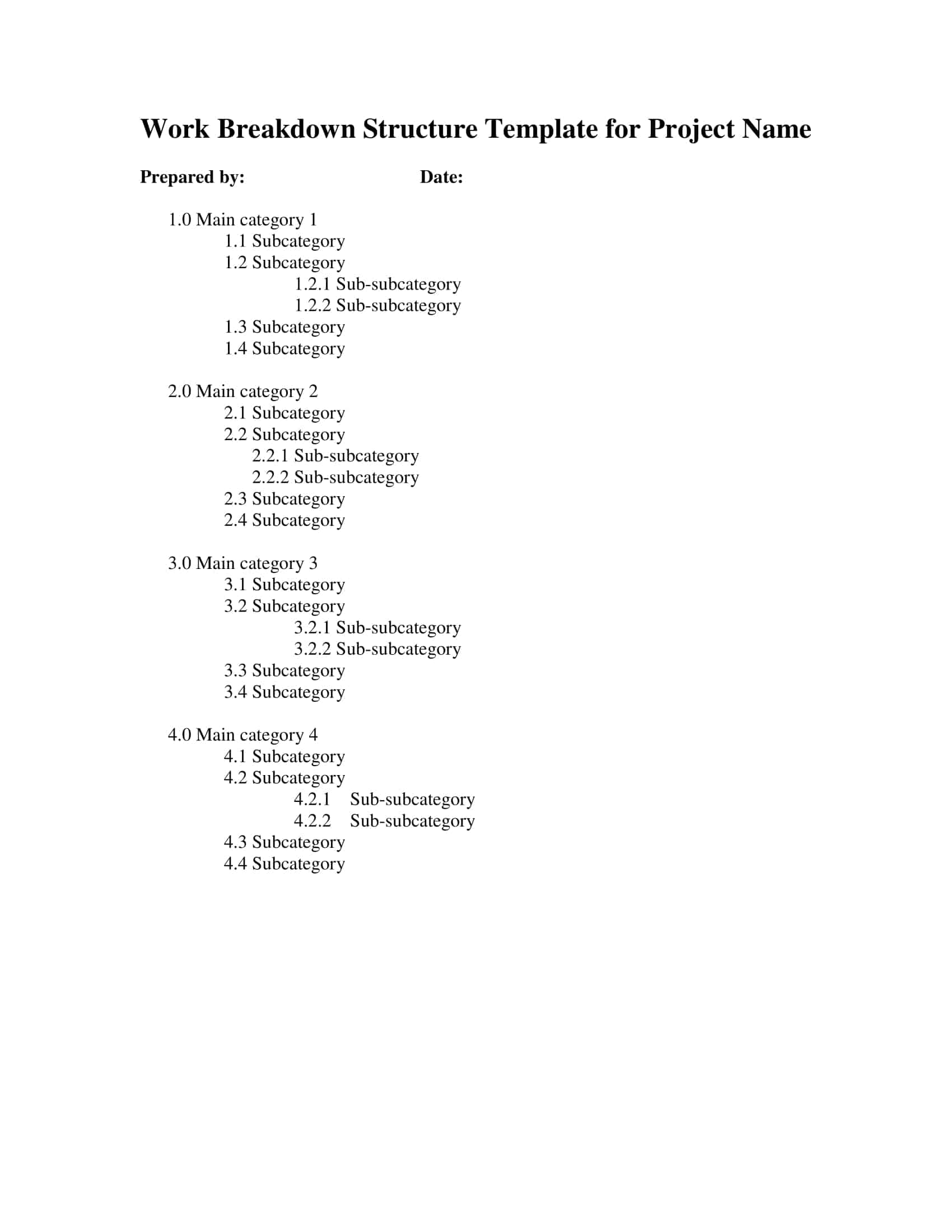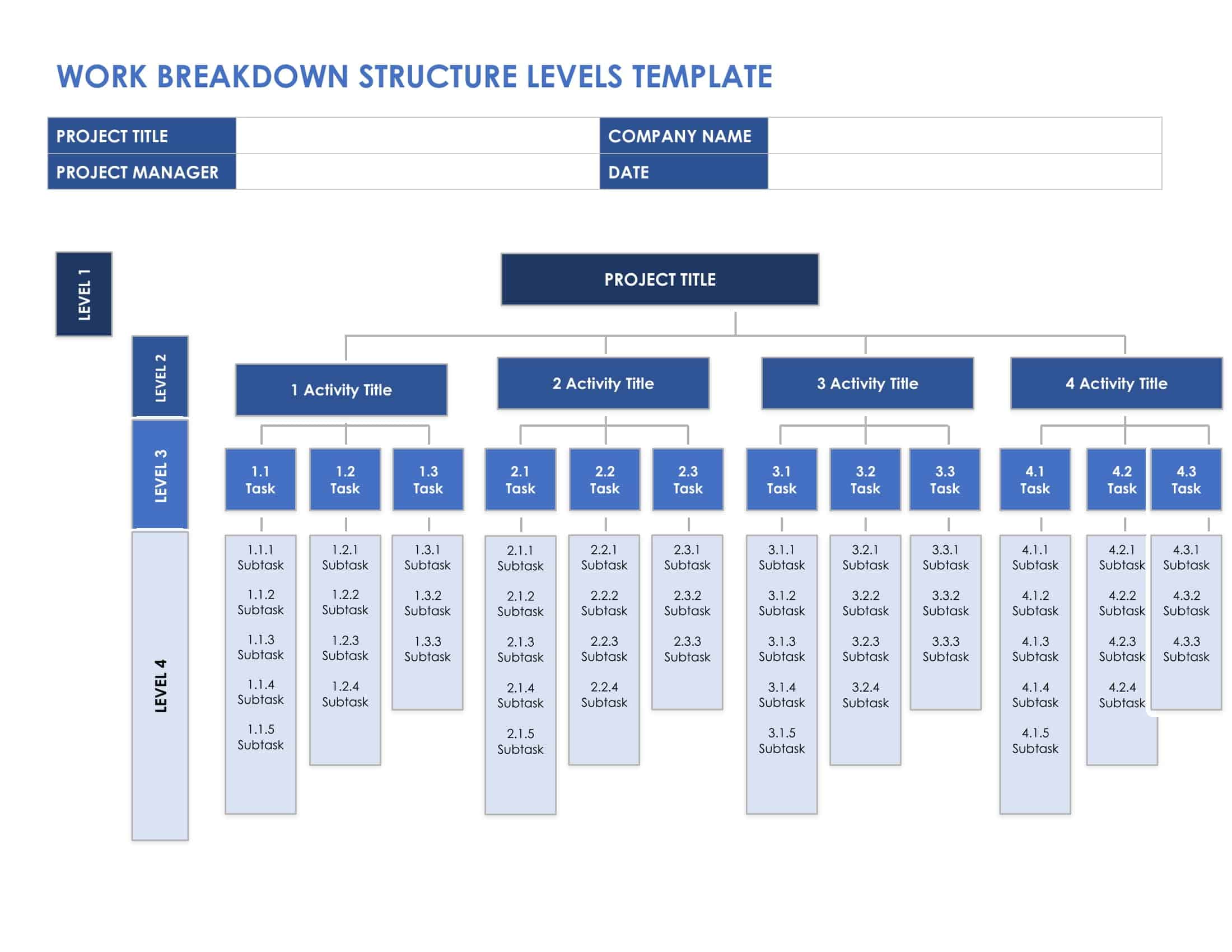One of the points where we need help with the projects is the definition of the scope and determining the necessary studies to realize the relevant scope after defining it.
After defining the scope, we usually try to come up with the project schedule. We need activities to be done to create a time plan, while activities require a hierarchically organized scope. The Work Breakdown Structure is the structure in which we converted the scope document into a hierarchical diagram.
Table of Contents
Work Breakdown Structure Templates
Streamline project planning and enhance project management efficiency with our dynamic collection of Work Breakdown Structure (WBS) Templates. A Work Breakdown Structure is a powerful tool that breaks down complex projects into manageable and organized components, allowing for better planning, resource allocation, and tracking of project deliverables. Our customizable and visually captivating templates provide a structured framework to define project scope, identify tasks and subtasks, allocate resources, and establish project timelines.
Whether you’re a project manager, team leader, or business professional, our templates offer a range of designs and layouts to suit your project’s unique requirements and objectives. From visualizing the project hierarchy and dependencies to tracking progress and assigning responsibilities, our templates enable you to effectively communicate project details, foster collaboration, and ensure project success. With customizable elements and user-friendly layouts, our templates make it easy to create comprehensive and visually appealing Work Breakdown Structures that enhance project clarity and control. Simplify project planning, improve team coordination, and achieve project milestones with confidence using our versatile and easy-to-use Work Breakdown Structure Templates. Download now and unlock the power of efficient project management.
What Is a Work Breakdown Structure?

Work Breakdown Structure (WBS) is a method used to manage projects’ complex and multi-step structure. In other words, the work breakdown structure is a method of breaking down the project to make it more manageable. It is a very useful way to divide the phases or outputs of the projects into parts and to facilitate the planning, execution, and control of the projects over these parts. We can think of the work breakdown structure as a form of representation, similar to an organizational structure that is hierarchically tiered and divides your project into smaller, more manageable parts.
Why is Work Breakdown Structure Important?
In order to remove the obscurity of the project and make it more accessible and meaningful, a work breakdown structure should be created. It allows you to see more clearly how to reach the goal. In this way, it will make the team more comfortable with psychology.
All work to be done throughout the project must be within the work breakdown structure. Works that are not in the work breakdown structure will become unacceptable within the project.
How to Get Started?
Creating a work breakdown structure is a method frequently used by employees in positions such as project managers and business analysts.
In the works for which you are solely responsible, You can construct this structure on paper or through computer programs.
When it comes to high-responsibility tasks, it is helpful to set up this setup in a way that everyone can see and discuss.
This structure will be very useful for you at every stage of the project, from planning and operation to implementation and control.
Work Breakdown Structure Creation Programs
You can create a work breakdown structure in programs such as Excel and Visio for projects whose sole stakeholder is ourselves. You can find various websites and applications on the Internet to create a work breakdown structure for larger and more complex businesses with multiple stakeholders.
For projects with more than one stakeholder, using cloud-based systems suitable for collaboration and instant reporting makes Business Structure Revise quite easy to follow. Thanks to the Work Program Management Software, as all stakeholders will act on the same screen and on the same data, teams that act by looking at the old work program are prevented from making mistakes.
Types of Work Breakdown Structures
In this part, we are going to discuss the different types of work breakdown structure templates. As mentioned above, any project needs to have a WBS. A work breakdown structure (WBS) is a tool that is used to break down the project into smaller components. It defines the tasks or activities needed to complete the project and helps you to identify what needs to be done, who will do it, when it needs to be completed, and how much it will cost.
The best way to explain how a WBS works is by using an example. Let’s say you are planning an event like a wedding anniversary party for your parents and want everything to be perfect for them. So, you decide on a venue for the event and start thinking about what else needs to be done. In order for this event to be successful, many things need attention, such as catering, decoration, music, entertainment, etc. With this in mind, let’s take a look at some of the different types of WBS templates that can help you plan your next event:
The first type of WBS is the verb-oriented work breakdown structure template. This type is used for projects which require different activities but have only one main objective. The activities are listed in a list and then further broken down into sub-activities.
The second type of WBS template is the noun-oriented work breakdown structure template. This type is used when different activities need to be performed by different departments or teams. The activities are listed in a list and then further broken down into sub-activities.
The third type of WBS template is called the time-phased work breakdown structure template. This type is used when you want to track how much time has been spent on each activity. It also helps you assess how much time will be required until the completion of each training and how much time will be saved by delegating specific tasks to other people (or teams).
Benefits of the Work Breakdown Structure
Creating a work breakdown structure prevents the work to be done from being skipped. It enables the team to see the steps toward reaching the goal more clearly and to understand their roles. It allows you to see and identify risks. It allows you to see changes’ possible effects and prevent them. It provides a more realistic estimation of time, resources, and costs and the needs of these criteria to be seen more clearly. It provides control capability. It provides the support of the project team and customers.
Project Management Knowledge Base Center (PMBOK)
PMBOK says that each project planning may differ in itself. In general, the 8/80 rule applies. This rule states that each work package should not be less than 8 hours and not more than 80 hours.
PMBOK defines the work breakdown structure as: “A method of breaking down deliverables and work on the project into smaller and manageable pieces.” Minor parts are called “Work Package.” Work packages are made up of names. Which activities will be carried out within the scope of a project, by whom these activities will be carried out, for how long, and at what cost are determined by the work breakdown structure.
The points to remember about the work breakdown structure are:
- Work breakdown structure is the entire scope.
- Nodes at the level below each node(“node”) in the hierarchy make up 100% of the parent node.
- In work breakdown structure activities are not included.
- The status of the work package, whether its completion is measurable or not.
- Whether the work package produces an output
- If a work breakdown structure does not contain a dictionary of work breakdown structure, each follower may perceive it differently.
It will be beneficial for you to have certain principles and to follow these principles when creating a work breakdown structure while performing earned value management later on.
For similar projects, performing the first few levels of work breakdown structure within a template framework will allow you to compare certain projects from these levels and make it easier for you to follow them in terms of the value they produce.
WBS and Client
In addition, one of the essential features of the work breakdown structure; is used in communication with the customer. It will enable the customers to see the business steps and the connections between them more clearly and understand them more easily.
In short, it will provide benefits in many aspects, such as reducing risks, creating a more comprehensive and better-defined network structure, and increasing the quality of communication.
FAQs
Does Excel have a WBS template?
Yes, Excel has downloadable WBS templates that provide the hierarchical table structure to outline tasks and subtasks. Columns, formatting, and instructions allow quick creation of a detailed WBS.
How do I create a WBS level in Excel?
In Excel, make each level of tasks its own row. Use indenting, bolding or color coding to show the hierarchical relationship. Number each row sequentially based on level. Add columns for task details like duration, owner, milestones. Filter or group rows by level.
What is a work breakdown structure template?
A work breakdown structure template in Excel, PowerPoint, Word or other formats contains the hierarchical table structure with standard columns and placeholder text. It provides a guide to easily enter your own task breakdown for a new project WBS document.
How do you write a work breakdown structure?
To write a work breakdown structure (WBS):
- Identify all major deliverables and tasks for the project.
- Organize tasks into logical groupings or levels.
- Break groups into manageable components.
- Outline deliverable relationships and dependencies.
- Number and code each task for tracking.
- Estimate timelines and resources needed.














































![Free Printable Credit Card Authorization Form Templates [PDF, Word, Excel] 1 Credit Card Authorization Form](https://www.typecalendar.com/wp-content/uploads/2023/06/Credit-Card-Authorization-Form-150x150.jpg)
![Free Printable Stock Ledger Templates [Excel,PDF, Word] 2 Stock Ledger](https://www.typecalendar.com/wp-content/uploads/2023/08/Stock-Ledger-150x150.jpg)
![Free Printable Financial Projections Templates [Excel, PDF] 3 Financial Projection](https://www.typecalendar.com/wp-content/uploads/2023/05/Financial-Projection-1-150x150.jpg)
